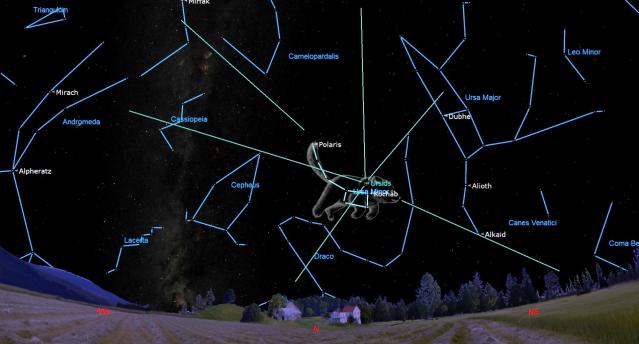The night sky is set to sparkle this weekend as the final meteor shower of 2023, known as the Ursids, reaches its peak. Here is everything you need to know about catching this celestial light show.
Brief Overview
The Ursid meteor shower occurs annually in mid-December, originating from the constellation Ursa Minor. This year it will peak on the nights of December 22nd and 23rd, with optimal viewing times shortly after midnight each night [1].
At peak activity, Ursid offers a modest 10 meteors per hour under ideal conditions. While less spectacular than other major annual showers, the Ursids stand out for often producing occasional outbursts with much higher rates [2].
The Ursids are so named because they appear to radiate from the vicinity of the bright orange star Kochab, the brightest star in the constellation Ursa Minor. Kochab is located near Polaris, the North Star [3].
This guide covers everything you need to know to spot these shooting stars, including peak dates and times, where to look, and viewing tips.
When is the Peak?
The Ursid meteor shower peaks on the night of December 22nd into the early hours of December 23rd. It will remain active from December 17th-26th, but peak activity is expected around December 22nd/23rd [4].
According to NASA meteor expert Bill Cooke, the best time to view the shower will be shortly after midnight on both peak nights, when the radiant point is highest in the sky [5].
During the peak window from around midnight-2am local time each night, you can expect to see around 5-10 meteors per hour if viewing under dark skies. The shower may also produce occasional bursts of more than 25 meteors per hour [6].
Where to Look
To best view the Ursids, locate the shower’s radiant point in the night sky, near the bright star Kochab in the constellation Ursa Minor. This is the point in the sky that the meteors will appear to radiate outwards from.
Kochab can be found by first identifying the familiar shape of the Big Dipper asterism of Ursa Major. Follow the curve of the Big Dipper’s handle until you reach Polaris, the North Star. Kochab is the moderately bright orange star located a few degrees away from Polaris [7].
 |
|---|
| Locating the Ursid radiant point near Kochab and the Little Dipper asterism of Ursa Minor. (Credit: NASA) |
Face the radiant point, allowing your gaze to roam between Kochab and Polaris. Any Ursid meteors will appear to originate here, racing outwards across the sky. They may appear anywhere overhead or off towards the horizon [8].
What Causes the Ursids?
The Ursid meteor shower occurs when Earth passes through debris trails left behind by comet 8P/Tuttle. Tiny comet particles, most no larger than a grain of sand, strike Earth’s atmosphere traveling at 33 km/s, vaporizing and causing visible incandescent meteors. 8P/Tuttle orbits the Sun every 13 years [9].
The Ursids have been observed for over 100 years, with rates typically low at around 10 meteors per hour. However, occasionally Earth encounters denser filaments of debris causing short-lived outbursts with rates three to five times higher. The last notable Ursid outbursts were in 1945 and 1986 [10].
While no major outburst is predicted this year, the waxing crescent Moon will set early allowing good viewing conditions. Any bright fireballs or bursts above the normal peak rate would make great bonuses [11].
Viewing Tips
To maximize your chances of spotting Ursid meteors, follow these viewing tips:
-
Get away from light pollution: Light pollution washes out faint meteors. Escape urban glow by finding dark country skies if possible.
-
Give your eyes time to adjust: Allow at least 15-20 minutes for your eyes to become dark-adapted for optimal viewing.
-
Face northeast: Position yourself with a good view of the Ursid radiant point above the northeastern horizon. Recline for comfort if desired.
-
Watch late night: Peak viewing is after midnight local time on December 22nd/23rd when the radiant is highest overhead.
-
Scan the skies: Meteors can appear in any part of the sky so watch the entire sky not just the radiant point.
-
Be prepared to stay out late: Dress very warmly, bring blankets, lawn chairs, snacks, hot drinks etc. Meteor watching involves patience.
-
Allow a few cloud-free hours either side of midnight: Don’t expect to see meteors appearing constantly. Ursid rates are generally low with lulls between activity.
What’s Next
The Ursid meteor shower marks the finale of 2023’s major annual meteor showers. The next notable display will be the popular Quadrantid meteor shower, which peaks briefly around January 3rd, 2024 [12].
In the meantime, keep an eye out for sporadic meteors which can appear any night of the year. Download astronomy apps like Night Shift and Star Walk 2 to stay abreast of celestial events happening near you.
Grab some blankets, snacks, family and friends and take advantage of the long winter nights ahead to do some casual meteor watching!
To err is human, but AI does it too. Whilst factual data is used in the production of these articles, the content is written entirely by AI. Double check any facts you intend to rely on with another source.



![Related image from Middle East Eye [https://middleeasteye.net]](https://www.bridgeguys.com/wp-content/uploads/2023/12/news_about_meteor_shower_ursid-150x150.jpg)